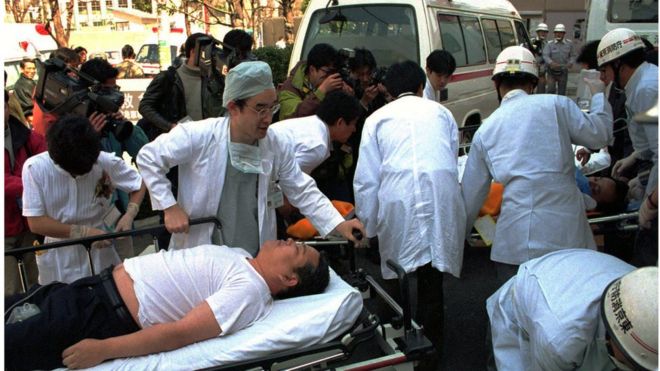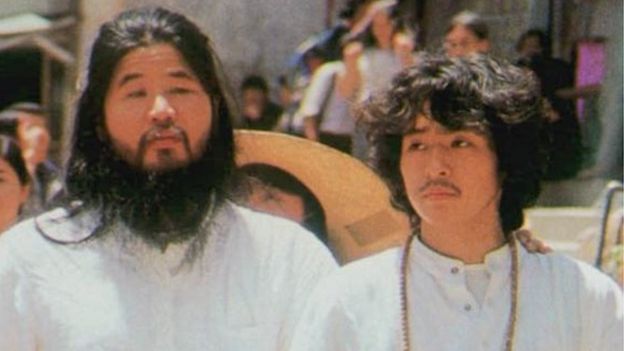
Russian police have carried out dozens of raids this week on properties linked to the Aum Shinrikyo cult.
Ten people were detained and dozens more are under investigation.
The arrests, and another recent crackdown in Montenegro, have thrown the spotlight back on this murky group.
Where did the cult come from?
It originated in Japan, where it was behind the deadly sarin nerve gas attack on the Tokyo subway in 1995.
Aum Shinrikyo, whose name means "supreme truth", began in the 1980s as a spiritual group mixing Hindu and Buddhist beliefs, later working in elements of apocalyptic Christian prophesies. The group's founder, Shoko Asahara, declared himself to be both Christ and the first "enlightened one" since Buddha.
The group, often shortened to just Aum, gained official status as a religious organisation in Japan in 1989. Asahara picked up a sizable global following, speaking at universities and writing books. At its peak, he had tens of thousands of members worldwide.

Asahara's top disciple, Yoshihiro Inoue, right, was sentenced to life in jail
Many of his followers in Japan were students at elite universities. Much has been made of the group's promise of a more meaningful life to young people from academically pressured backgrounds who had to look forward to similarly pressured careers.
The group gradually became a paranoid doomsday cult, convinced the world was about to end in World War Three and that only they would survive.
It also became increasingly violent, kidnapping, injuring, and killing opponents, and even using chemical and biological agents in other attacks.
What happened in Tokyo?
On 20 March 1995, during rush hour, cult members punctured bags filled with a liquid form of the nerve agent sarin, using sharpened umbrellas, on train lines that went through Tokyo's political district.
The attack killed 13 people and injured thousands more.
In subsequent months, cult members carried out several failed attempts at releasing hydrogen cyanide in various stations.
The 1995 attack shocked Japan, a country that prided itself on low crime rates and social cohesion. It also raised questions about police failings to investigate previous allegations of criminal activity by the group.
Scores of Aum members have faced trial over the attack - 13 were sentenced to death, including Asahara, who remains on death row.
The last to be tried in connection with the subway attack was Katsuya Takahashi, arrested in June 2012 after being on the run for 17 years. He was sentenced to life in jail.
Cult member Makoto Hirata was also jailed in 2014 for the abduction of a 68-year-old man and his involvement in two bomb attacks.
Why are they in Europe now?
The group went underground after Tokyo, but did not disappear, eventually renaming itself Aleph.
Another, smaller group, Hikari no Wa (Circle of Rainbow Light), headed by Aum's former spokesman and Asahara's successor Fumihiro Joyu, was formed in 2007.
Joyu claimed to have distanced his group from worship of Asahara.
The group had operations in the former Soviet states in the upheaval following the collapse of the USSR, but the region has become increasingly important in recent years.
In late March, Montenegro expelled 58 foreigners suspected of association with Aum Shinrikyo. They were gathered at a hotel they had rented in the tiny former Yugoslav state.
Four were from Japan, the interior ministry said, but 43 from Russia, seven from Belarus, three from Ukraine, and one from Uzbekistan.
The Russian raids in early April targeted 25 properties.
The group is illegal in Russia but prosecutors said it may have up to 30,000 Russian followers, and has been pressurising people for donations.
Officials have opened a criminal investigation, saying the group's activities "involve violence against citizens and injury to their health," state media reported.
And in Japan?
Aum Shinrikyo is designated as a terrorist organisation in the US and many other countries, but Aleph and Hikari no Wa are both legal in Japan, albeit designated as "dangerous religions" subject to heightened surveillance.
Some estimates say they have 1,500 followers between them, with reports the number is slowly growing.
A few human rights advocates have defended those members who have not been found guilty of crimes, saying they were unaware of plans to attack the Tokyo subway.
But members face little prospect of receiving social or official acceptance, despite attempts to distance themselves from the events of 21 years ago.



No comments:
Post a Comment